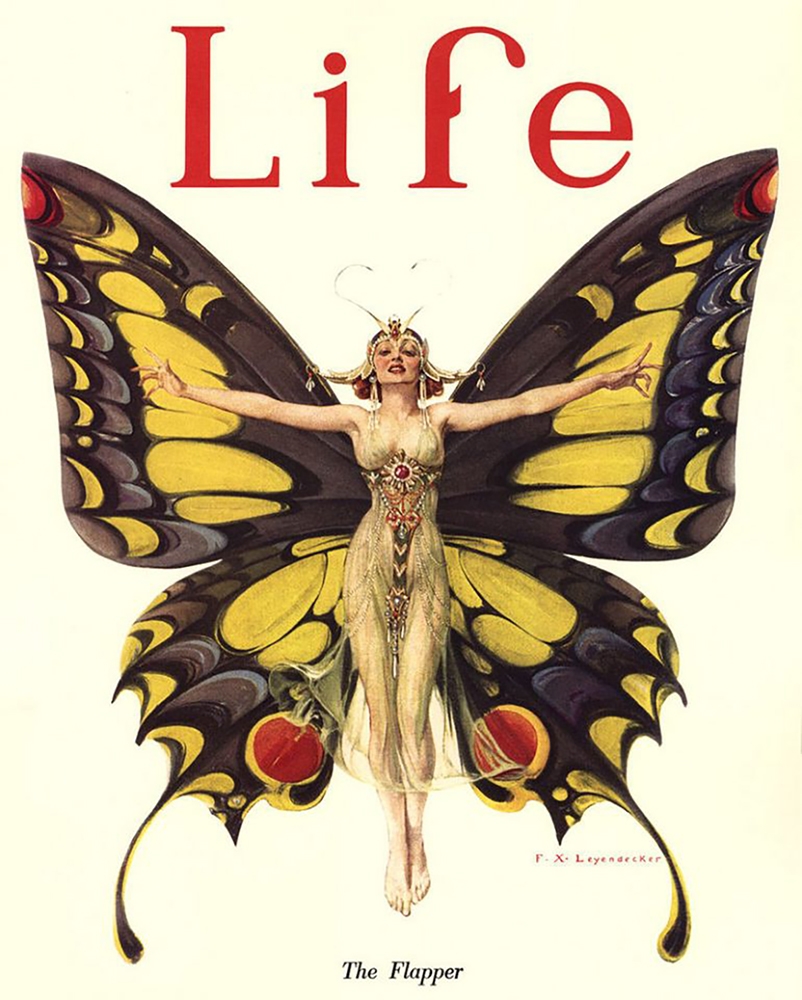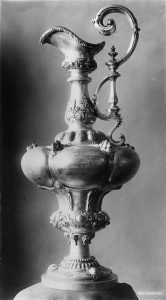Winner of the Fall 2016 StMU History Media Award for
Best Article in the Category of “Culture”
When one thinks of the 1920’s era one immediately thinks about Flappers. A flapper was considered a young woman who was very fashionable. This was a young female who enjoyed life to the fullest, flouting her unconventional standards of behavior and carefree party lifestyle.1 The spirit behind this movement was all about leaving the traditional ways of life behind and transforming into an independent woman.

Before World War I, the concept of femininity was referred to as the Gibson Girl. This term was used to describe these new independent and often well educated women. Gibson girls wore their hair long, pinned up and adorned with beautiful hats. They completed their ensemble by wearing long skirts and blouses that buttoned up to their necks. Despite their feminine appearance, these women were more than capable of doing the same things that men did. Examples of this include activities such as playing sports: skating, golfing, bicycling, tennis. These young ladies did not go out until they were asked properly by a young man who had good intentions and a promise of marrying them. Gibson Girls soon broke away from their traditional ways.2
In 1915, two years before America’s entry into World War I, a famous author by the name of H.L. Mencken introduced the word “Flapper” to the United States. Mencken stated that a flapper was “a woman who consumed music, literature and periodicals voraciously taking her cues for behavior and style from the media in front of her rather than the moral codes of decorum.”3 Another famous author, F. Scott Fitzgerald, famous for his classic novel The Great Gatsby, described the flapper as “lovely, expensive, and about nineteen.” John Held Jr., who was an American cartoonist, emphasized the flapper by drawing young girls wearing unbuckled galoshes that would make a “flapping” noise when walking.4 Despite the many different terms, Flappers were described essentially the same way: they were young girls who enjoyed the party life and had a sense of fashion.
After World War I ended in 1918, many things had changed for the men returning home, particularly the roles and values that women were embracing. The traditional values were gone and in their place came a faster, sleeker, and more daring approach to life. This time period not only ushered in an era of change in values, but it also established a new baseline for what was considered feminine. The Flapper Age was born and it brought with it a new and independent woman. These women smoked, drank, voted, cut their hair into bobs, wore eyeliner, and went to as many parties as they could—enjoying every bit of the social life along the way.5

During the 1920’s, fashion changed drastically due to a very famous designer, Coco Chanel. This woman helped flapper fashion to stand on its own. Typical flapper clothing included a simple sack like dress, which allowed women of all classes to make their own dresses and remain on trend.6 The waist of the dress was dropped to the hipline, and the skirt fell just below the knee. Stockings made of rayon were added and worn over a garter belt. To complete the look, bracelets were added and necklaces ran from the neck to the waist. Cloche hats sat atop their heads and drew the eye into a new hairstyle trend known as the bob.7 The make-up of flappers consisted of a red powder or cream that was used for the lips and cheek, eye-liner, powder for the face, and red lipstick that became very popular.
On January 19, 1919, the Eighteenth Amendment, also known as the Volstead Act, came into effect and gave way to the Prohibition Era in which the sale, production, importation, and transportation of alcohol was banned across the nation.8 This change in the legal system caused the sale and consumption of liquor and alcohol to go underground. The most rebellious thing a flapper could do at this time was to consume alcohol, and these young girls had a reputation for being giddy. The following year, on August 18, 1920, the Nineteenth Amendment was passed and women now had the right to vote.9 In 1924, the first radio launched more than 600 commercial channels around the U.S. The radio at the time was the social media on the flapper life. Many young girls swarmed the theaters to see the image of the flapper on screen. Famous actress Clara Bow, starred in the “Flapper” and made the look iconic.
On December 2, 1927, Henry Ford invented the Model A vehicle and car sales increased.10 Women were now owners of vehicles, and the car became a lifeline to a world full of excitement for the flapper in particular. With no one to stop them, they were free to come and go as they pleased. Liberated women were now able to go out and enjoy dancing during this era that was the Jazz Age. The most popular thing for a flapper to do was to go to a nightclub where she would drink, dance, and show off her moves. The era of the Flapper, however, came to an end with the Wall Street Crash of 1929. Many young women lost their jobs and the incomes that had given them such independence.11
Life in the 1920’s left a huge legacy for women to this day. Flappers and the forward-thinking concept of the modern woman is what initiated the change in society for how women were viewed then as well as how they continue to be viewed in present day. With their bold choice in attire, along with their new views and attitudes regarding femininity, both in fashion as well as social conduct, Flappers left behind the old traditional ways and paved the road for a more liberated female.
- Salem Press Biographical Encyclopedia, January 2016, s.v. “Flappers,” by R.L. Smith. ↵
- Kelly B. Sagert, Flappers: A Guide to an American Subculture (Greenwood Publishing Group, 2010), 1-2. ↵
- Brian DiPaolo, Flappers: Issues & Controversies in American History (Infobase Publishing, 2007), 4-5. ↵
- DiPaolo, Flappers: Issues & Controversies in American History, 4-5. ↵
- Soo Hyun Park, Flapper Fashion In the Context of Cultural Changes of America in the 1920’s (CUNY Academic Works, 2014), 1-2. ↵
- Salem Press Biographical Encyclopedia, January, 2016, s.v. “Flappers,” by R.L. Smith. ↵
- Sagert, Flappers: A Guide to an American Subculture, 3. ↵
- Sagert, Flappers: A Guide to an American Subculture, 5. ↵
- DiPaolo, Flappers: Issues & Controversies in American History, 2. ↵
- F.L. Allen, Only Yesterday: An Informal History of the Nineteen Twenties (National Humanities Center, 1931), 5. ↵
- Alan Brinkley, American History: Connecting with the Past Volume 2, 15 edition (New York: McGraw-Hill Education, 2014), 643. ↵




213 comments
Jose Chaman
I don’t know much about the 1920s, much less what life was like for women during those days. However, thanks to this article I have been able to delve deeper into this unique legacy for society with respect to women. Flappers (and Coco Chanel) left a great legacy of strength and elegance that defined a historical beginning for society. Excellent cultural article.
Olivia Tijerina
Personally, I have never put into from the 1920’s woman as a place to be an influential point to woman in the future. Moreover, I am glad to have received for this message to be so because having the perspective that a woman had to start form someone, weather it be appropriate then for society. Having given the perspective that it was the “flappers” that gave momentum for future societies is a big takeaway.
Brisella Olivares
In my high school English class, I remember reading the book “The Great Gatsby” and watching the movie. From what I understand the 20s was a good year for women with having the right to vote and better educational opportunities and not to mention their wonderful sense of style.
Brisella Olivares
The 20s was such a live and rebellious time to live in. Women were free to be themselves and independent instead of being considered property to men.
Courtney Pena
I remember writing an extended essay in high school about how historical events impacted women’s fashion in America and I wrote about the Roaring Twenties leading to the creation of flappers. I remember writing about actresses at the time such as Joan Crawford, Louise Brooks, and Gloria Swanson being known as Hollywood’s fashionable flappers and that American women looked up to them. Just like this article states, American women cut their hair in bobs, wore eyeliner, and would dance. This changed the way men viewed women since prior to the 1920’s, women were more conservative.
Diego Terrazas
The 20’s was an interesting time indeed. With the existence of flappers, prohibition, and speakeasy’s I can imagine how rebellious the youth was. I was not aware that Coco Chanel was this old, let alone had such a great social impact. A good thing about this era is that it allowed women to express individuality and overall empowered young women.
Amariz Puerta
The title just gave me Great Gatsby vibes, this has to be one of my favorite periods of time. I think it is so cool being able to look back at the period of time and see how much we have progressed in music, style, and culture. Although this was a time of prosperity. There were also many great advancements for African American culture.
Sharriah Martinez
I remember learning about the roaring twenties in high school history. My teacher Mr. Ramirez made it so interesting by him showing us videos, and visuals of what these people did. Learning about flappers was so interesting to me they felt strong and motivated. Yes society conformed back into its old ways , but they got a taste of what they would soon be fighting for. This article was very well written and a nice refresher to what i remember learning about in high school.
choosub sabatoonys
nice
Maya Mani
Great article! The roaring twenties seemed to be a time where women defied the social norms. They were classy and had a great sense of style, but did not allow themselves to be associated with negative connotations. I read The Great Gatsby and was fascinated by Daisy. We’ve come a long way since then, but it’s great to see that women were breaking the social norms back then.
Eric Ortega Rodriguez
I am fairly certain that when people hear of the 1920s, the first thing that comes to mind is Flappers. This was groundbreaking during the time, women had so much freedom they did not usually have. The author does an amazing job explaining that women were able to vote, smoke, and even drive a car. This is a very important time period in history and this article does a good job in capturing this time in history. Great work.